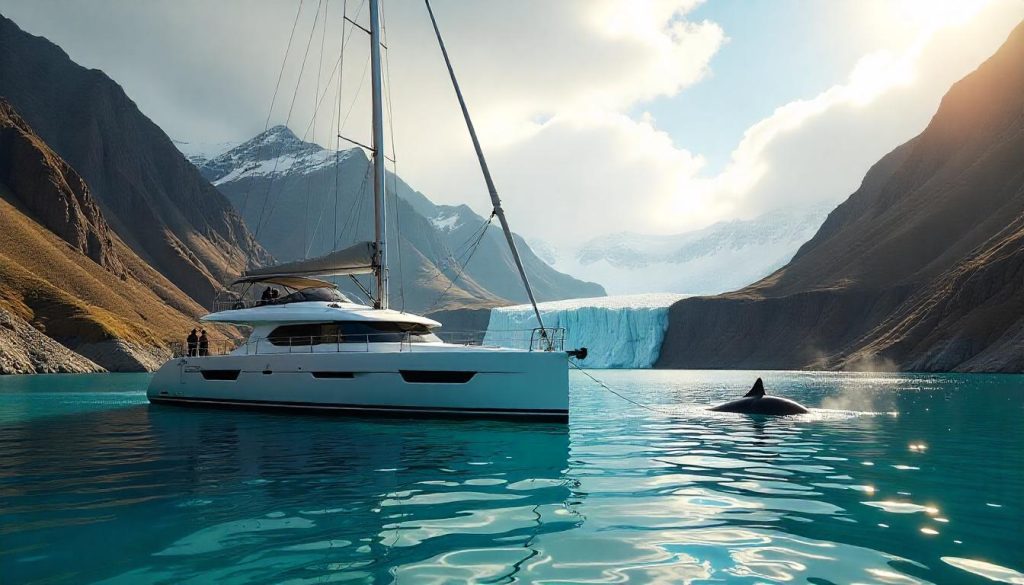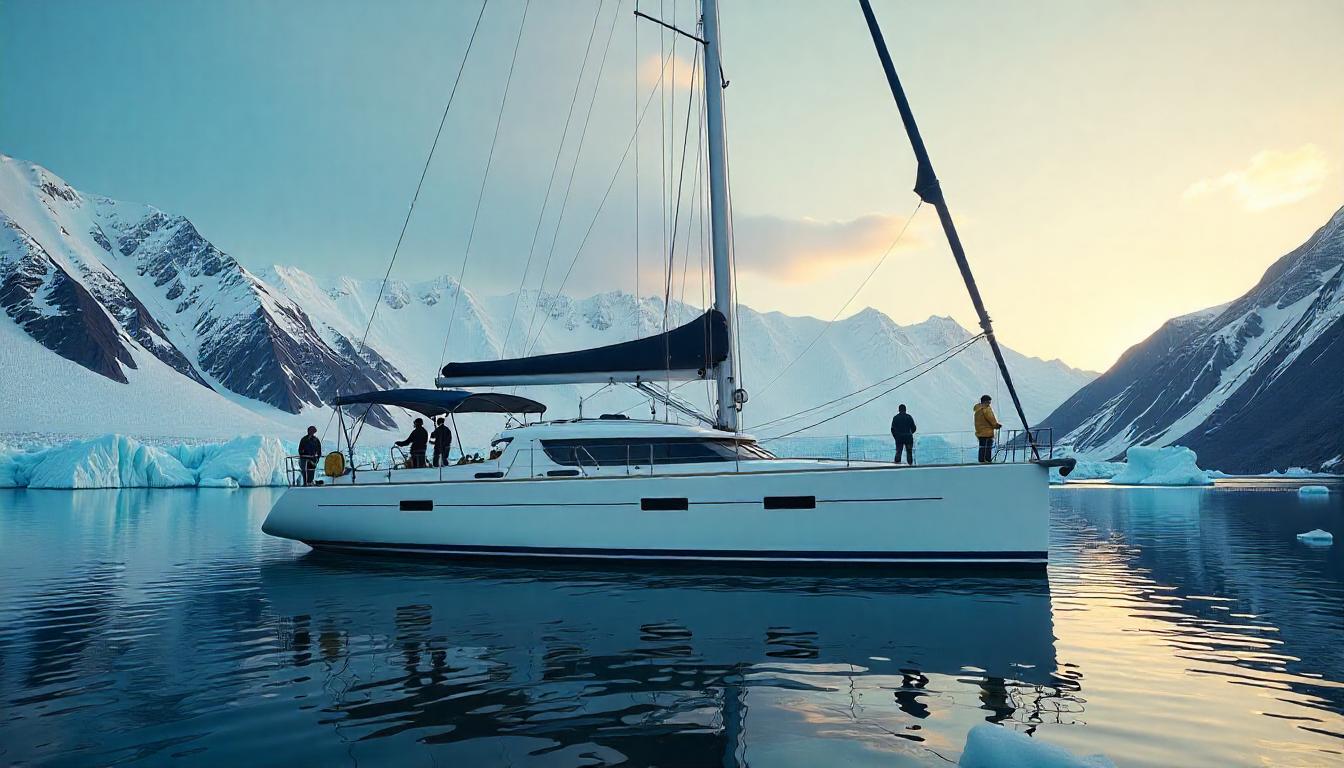Patagonia, a vast region spanning Chile and Argentina, offers some of the most untouched landscapes on Earth, and Patagonia yachting Chile in 2025 provides an extraordinary way to explore its remote waters. With over 80,000 kilometers of coastline, including fjords, channels, and glaciers, Chilean Patagonia is a sailor’s dream for adventure and solitude. The region’s waters average 8°C in summer, per marine data, and are home to diverse wildlife like humpback whales and Magellanic penguins. In this guide, we’ll navigate the best routes, highlight must-see destinations, and share practical tips for yachters. Let’s set sail into Chile’s wild and breathtaking waters.
Puerto Montt: The Gateway to Patagonia Yachting Chile
Puerto Montt, located at the northern edge of Chilean Patagonia, serves as the gateway for Patagonia yachting Chile, offering a practical starting point for sailors. Begin at Marina del Sur, a modern facility in Puerto Montt. For example, Marina del Sur accommodates yachts up to 50 meters. It has 60 berths and depths of 5-7 meters, per port data. Also, the marina provides fuel, water, and provisioning services. You can explore the Angelmó market, where vendors sell smoked salmon for $10 per kilo, reflecting local flavors, per vendors. The area’s winds average 10 knots, per forecasts. Thus, Puerto Montt is an ideal base for your Patagonian journey.
Chiloé Island: A Cultural Stop Near Puerto Montt
Chiloé Island, a short sail from Puerto Montt, offers a cultural stop for sailors. Anchor near Castro in depths of 4-6 meters, suitable for yachts up to 40 meters, per charts. For instance, the island’s waters average 9°C, with visibility up to 10 meters, per reports. Also, Castro’s palafitos—colorful stilt houses—line the shore, a UNESCO site, with guided tours at $15, per operators. You can visit the San Francisco Church, a wooden structure painted yellow, for free, per guides. Moreover, local eateries serve curanto, a seafood stew, for $20, per menus. This cultural gem makes Chiloé a highlight. Therefore, it’s a must-visit for yachters near Puerto Montt.
Caleta Tortel: A Wooden Walkway Village
Caleta Tortel, further south, provides a unique stop with its wooden walkways instead of roads. Anchor in depths of 5-7 meters, suitable for yachts up to 50 meters, per data. For example, the village’s waters average 8°C, with visibility up to 15 meters, per reports. Also, the walkways stretch 7 kilometers, connecting cypress-wood houses, per guides. You can tender to shore and explore the village, with no entry fees, per locals. Additionally, the surrounding fjords offer views of the Baker River’s turquoise waters, per visitors. This remote village makes Caleta Tortel a standout. Thus, it’s a great detour for sailors seeking authenticity in Patagonia.
Beagle Channel: A Scenic Route for Patagonia Yachting Chile
The Beagle Channel, a narrow waterway near Tierra del Fuego, offers a scenic route for Patagonia yachting Chile, surrounded by dramatic landscapes. Start in Puerto Williams, the southernmost town in the world. Puerto Williams has a small marina accommodating yachts up to 40 meters. It has depths of 4-6 meters, per port data. For instance, berthing fees average $30 per night for a 40-meter yacht, per tariffs. Also, the town’s museum, Martin Gusinde, charges $5 for entry, showcasing indigenous history, per guides. The channel’s winds average 12 knots, per forecasts. Thus, the Beagle Channel is a breathtaking passage for sailors.
Pia Glacier: A Glacial Wonder in the Beagle Channel
Pia Glacier, along the Beagle Channel, offers a glacial wonder for yachters. Anchor in depths of 6-8 meters, suitable for yachts up to 50 meters, per charts. For example, the glacier’s ice calves into the sea, creating a dramatic display, per guides. Also, the waters average 7°C, with visibility up to 10 meters, per reports. You can tender closer to the glacier, spotting icebergs floating nearby, a common sight, per locals. Moreover, the surrounding peaks, part of the Darwin Range, rise 1,500 meters, per data. This icy spectacle makes Pia Glacier a highlight. Therefore, it’s a must-see for sailors in the Beagle Channel.
Cape Horn: The Southernmost Challenge
Cape Horn, at the southern tip of South America, provides a challenging stop for adventurous sailors. For instance, the area’s waters average 6°C, with swells reaching 3 meters, per reports. Also, winds can gust up to 30 knots, requiring careful navigation, per forecasts. You should anchor in a sheltered bay like Caleta Martial in depths of 5-7 meters, suitable for yachts up to 40 meters, per charts. The Cape Horn Monument, accessible by tender, honors sailors who’ve braved the passage, per guides. Additionally, albatrosses soar overhead, a thrilling sight, per locals. This iconic spot makes Cape Horn a standout. Thus, it’s a bucket-list destination for yachters in Patagonia.

Golfo de Penas: A Remote Passage in Patagonia
The Golfo de Penas, a vast gulf along Patagonia’s coast, offers a remote passage for sailors exploring Chile’s waters. This area requires careful planning due to its exposure to the Pacific. For example, swells can reach 4 meters, with winds averaging 15 knots, per forecasts. Also, the waters average 8°C, with visibility up to 15 meters, per reports. You should navigate during a weather window, ideally in summer, per guides. Moreover, the gulf’s isolation provides a sense of adventure, with no facilities nearby, per data. Thus, the Golfo de Penas is ideal for experienced sailors seeking solitude.
Messier Channel: A Sheltered Route
Messier Channel, south of Golfo de Penas, provides a sheltered route through Patagonia’s fjords. Anchor in depths of 5-7 meters, suitable for yachts up to 50 meters, per charts. For instance, the channel’s waters average 8°C, with visibility up to 20 meters, per reports. Also, the surrounding cliffs rise 1,000 meters, creating a dramatic backdrop, per guides. You can spot sea lions basking on rocks, a common sight, per locals. Additionally, the channel’s narrow passages require careful navigation, with depths dropping to 10 meters, per data. This scenic route makes Messier Channel a highlight. Therefore, it’s a great passage for sailors in Patagonia.
Bernardo O’Higgins National Park: A Glacial Sanctuary
Bernardo O’Higgins National Park, accessible via the Messier Channel, offers a glacial sanctuary for yachters. For example, the park spans 3.5 million hectares, the largest in Chile, per park data. Also, the Tempano Glacier, within the park, calves into the fjord, with waters averaging 7°C, per reports. You can anchor in depths of 6-8 meters, suitable for yachts up to 50 meters, per charts. The park’s rangers offer guided tours for $40 per person, per operators. Moreover, the area’s biodiversity includes Andean condors soaring above, per guides. This pristine spot makes Bernardo O’Higgins a standout. Thus, it’s a must-visit for nature lovers in Patagonia.
Kawésqar National Park: A Wilderness Escape
Kawésqar National Park, further south, offers a wilderness escape for sailors exploring Chile’s remote waters. This park, spanning 2.8 million hectares, is a UNESCO Biosphere Reserve, per data. For instance, anchor near the Eyre Fjord in depths of 5-7 meters, suitable for yachts up to 50 meters, per charts. Also, the fjord’s waters average 7°C, with visibility up to 15 meters, per reports. The park’s glaciers, like Amalia, create a stunning backdrop, per guides. You should bring supplies, as there are no facilities, per park rules. Thus, Kawésqar National Park is perfect for an off-grid adventure.
Amalia Glacier: A Frozen Spectacle
Amalia Glacier, in Kawésqar National Park, provides a frozen spectacle for yachters. For example, the glacier’s face stretches 2 kilometers wide, calving into the fjord, per park data. Also, the waters average 7°C, with visibility up to 10 meters, per reports. You can tender closer to the glacier, hearing the ice crack, a thrilling experience, per visitors. Additionally, the surrounding fjords are home to humpback whales, often spotted in summer, per guides. This icy wonder makes Amalia Glacier a highlight. Therefore, it’s a top stop for sailors in Kawésqar National Park.
Pío XI Glacier: The Largest in South America
Pío XI Glacier, also in Kawésqar National Park, offers a chance to see South America’s largest glacier. For instance, the glacier spans 1,265 square kilometers, per data. Also, the waters near the glacier average 7°C, with visibility up to 15 meters, per reports. You can anchor in depths of 6-8 meters, suitable for yachts up to 50 meters, per charts. The glacier’s blue ice towers 75 meters above the water, per guides. Moreover, the area’s remoteness ensures a pristine environment, with no human settlements nearby, per park rules. This massive glacier makes Pío XI a standout. Thus, it’s a must-see for yachters in Patagonia.
Practical Tips for Patagonia Yachting Chile
Patagonia yachting Chile in 2025 requires careful preparation for a safe journey. For example, the best time to sail is December to March, when temperatures average 10°C, per Chilean climate data. Also, stock up on supplies in Puerto Montt, as facilities are scarce further south, per guides. You should carry updated charts, as fjords like Messier Channel have sudden depth changes, per data. Additionally, pack warm clothing, as winds can drop temperatures to 5°C, even in summer, per forecasts. Thus, preparation ensures a seamless sailing experience.
Best Time to Sail Patagonia
Timing your sailing trip enhances your Patagonian experience. December to March offers the best conditions, with longer daylight hours, per forecasts. For instance, January provides up to 16 hours of daylight, ideal for exploring Kawésqar National Park, per data. However, spring and autumn bring cooler temperatures at 5°C, with stronger winds, per reports. Also, the shoulder seasons make anchorages like Caleta Tortel quieter, per guides. Winds average 10-20 knots in summer, per forecasts. Therefore, summer is the best time for sailing Patagonia’s waters.
Navigating Chile’s Waters Safely
Navigating Chile’s waters safely ensures a worry-free trip. For example, narrow passages in the Beagle Channel need updated charts, as depths can drop to 5 meters, per data. Also, local guides in Puerto Williams cost $50 per day, helping navigate tricky areas like Golfo de Penas, per guidelines. You should monitor VHF channel 16 for weather updates, as fines for non-compliance can reach $150, per Chilean law. Additionally, avoid anchoring in glacier zones without permission, per regulations. This preparation keeps your journey smooth. Thus, navigation tools and local expertise are essential.
Conclusion: Patagonia Yachting Chile in 2025
Patagonia yachting Chile in 2025 offers an unparalleled adventure through some of the world’s most remote waters. Puerto Montt provides a practical start with Chiloé Island’s culture. The Beagle Channel showcases glaciers like Pia, while Kawésqar National Park offers wilderness with Amalia Glacier. Also, careful planning ensures a safe journey through these pristine fjords and channels. Thus, set sail in 2025 and discover why Chilean Patagonia remains a yachter’s ultimate frontier, blending raw nature and solitude in one extraordinary trip.


